07/02/2023
In this insight, we explore patent trends and statistics at the European Patent Office (EPO) in the field of Artificial Intelligence (AI).
AI is on the Up
In our previous insight in 2021, we saw how the rate of filing European patent applications in the field of AI has shown a dramatic increase since 2015. We were also starting to see a corresponding increase in the number of AI applications being granted at the EPO.
We have revisited and updated the patent filing and grant data at the EPO in the graph below, and the signs remain promising for applicants engaged in AI innovation.
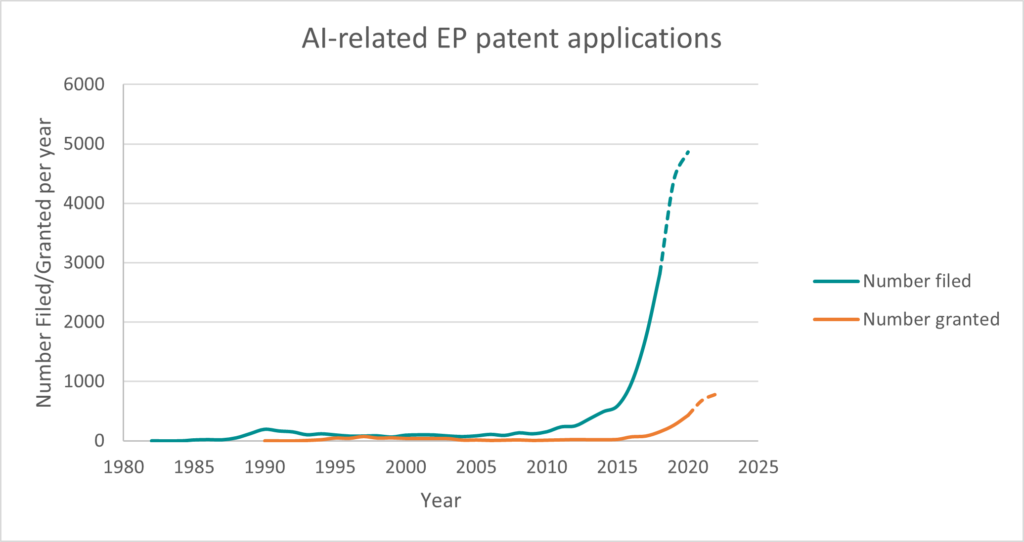
The graph shows all European patent applications and granted patents in the following Cooperative Patent Classification (CPC) classifications groups:
G06N 3/xx – Computer systems based on biological models
G06N 5/xx – Knowledge-based models
G06N 7/xx – Specific mathematical models
G06N 20/xx – Machine Learning
The dashed sections of the trendlines show the changes since our previous insight.
As can be seen, the rapid increase in AI-related applications being filed at the EPO continues, with almost 5000 applications being filed in 2020 alone (filing data for 2021 and 2022 is not yet available, as patent applications are not published until 18 months after filing).
Obtaining a granted patent in Europe typically takes a number of years, and therefore it is no surprise that the number of granted AI applications is currently considerably lower than the number being filed each year. However, we are pleased to see that the number of AI applications being granted by the EPO also continues to increase.
In 2022, 786 European patents were granted for AI-related inventions, up from 683 in 2021 and 433 in 2020. Given the continued increase in the number of AI applications being filed, we expect the number being granted to continue to increase year-on-year.
The increase in the number of granted applications each year does appear to be easing up, however. This could be attributed to a number of factors, such as saturation of the examining capability at the EPO, resulting in a longer wait for grant, or perhaps that many of the applications filed in the rush of the past few years could have been somewhat speculative, and are struggling to meet the patentability requirements at the EPO. Either way, more AI-related applications are being granted per year than ever before.
Top Applicants
If we look at all applications that were published in 2022 and classified in one of the above AI CPC codes, we find that the top ten applicants contain few surprises. Many of the big names appear, with Microsoft having the most applications published last year, closely followed by Google in second, and Samsung in third (Samsung having occupied the top spot for the two years prior).
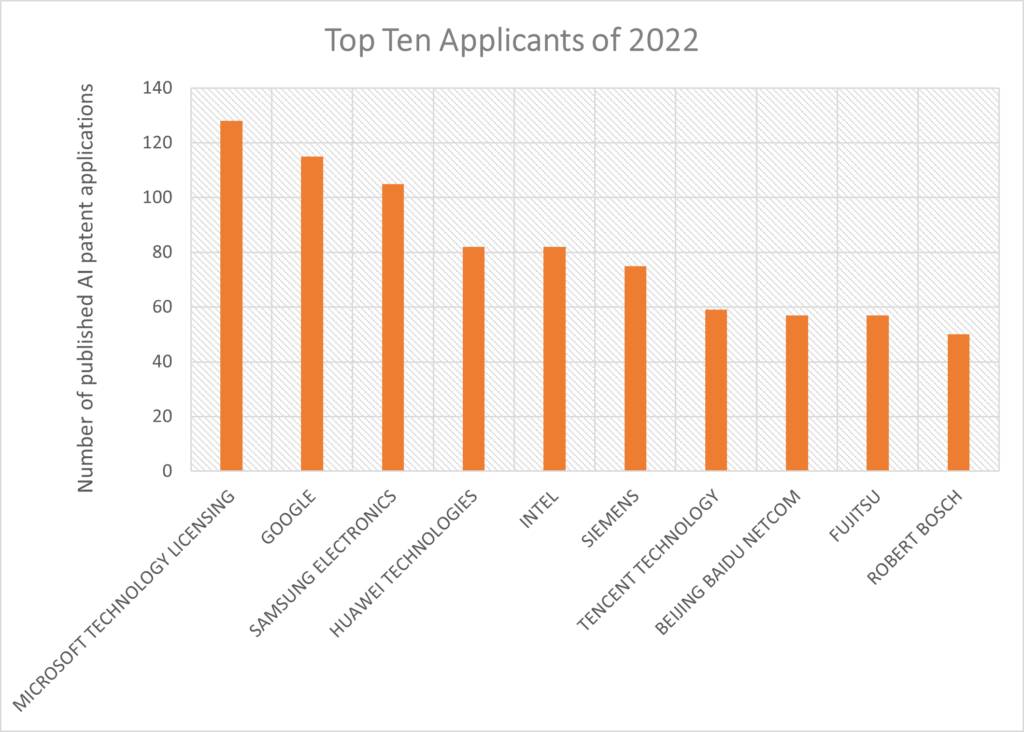
Taking the above graph and adding the data for the previous five years for each company, we see that most companies have a general upwards trend in the number of filed AI applications. Interestingly, many of these applicants appear to have had bumper years in 2020 and more so in 2021, with the number of published applications then dropping off in 2022. This drop off could perhaps be due to a decrease in the number of applications filed 18 months earlier at the beginning of the COVID-19 pandemic.
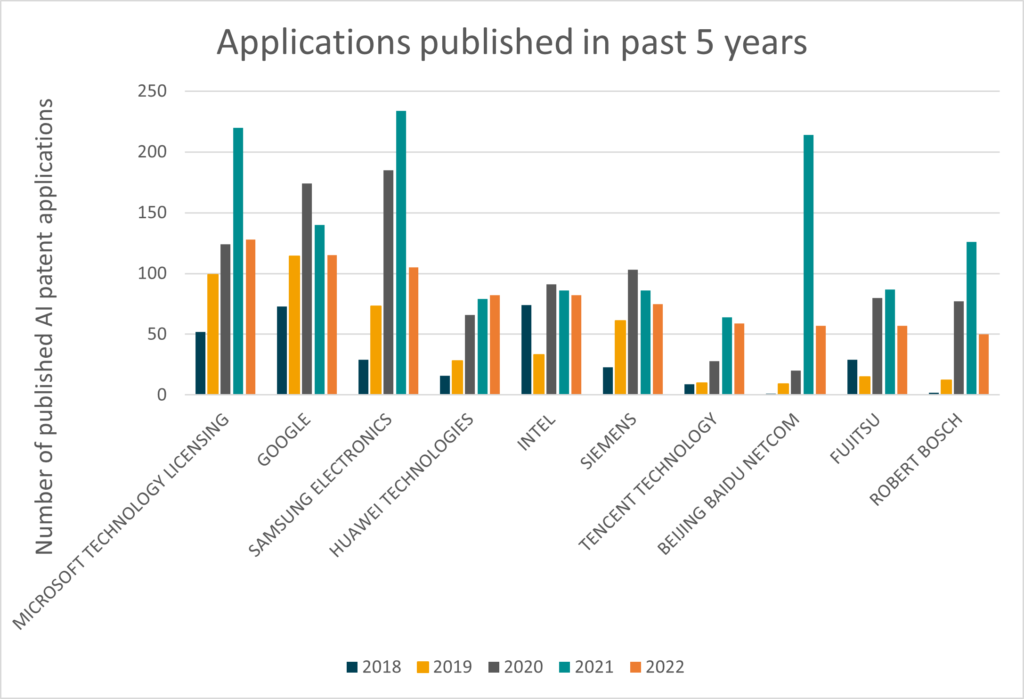
Each of these companies should be encouraged by the continued upward trend in the number of granted European patents, and will no doubt continue to secure their market position through patent filings.
Top Areas of Technology
Another interesting aspect of the AI data is the distribution of cases among different fields of technology. We all know that AI is a highly disruptive technology, and has the power to revolutionise almost any industry – from farming to drug discovery. We have analysed the patent applications published over the last year to extract the ten most common fields of technology to which those applications relate. To do this, we have again utilised the CPC codes assigned to each application by a patent examiner.
The results are shown below, with the CPC codes replaced with a brief description of the corresponding technology.
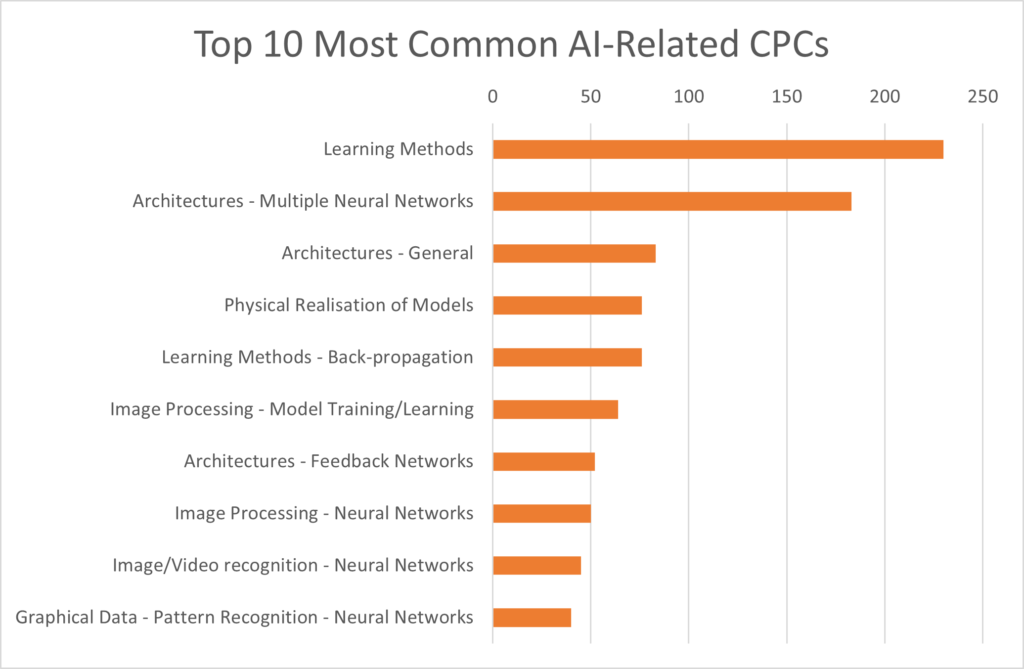
The first clear trend that emerges from the results above is that core AI (developments in AI algorithms themselves) makes up the majority of applications. It should however be noted that this may partly be due to the nature of the CPC classification system – there are a wider range of applied AI classifications. While applied AI classifications were well-represented in the data, many did not make the top ten.
Four out of the top five most common fields of technology relate to methods of training AI models, and developments of the algorithms themselves including new model architectures. A possible explanation for this links back to the disruptiveness of AI as a technology. AI is constantly being applied in new industries, and each new industry brings specific challenges that necessitate the development of new AI models and algorithms.
An interesting entry in the top five is the physical realisation of models. This field of technology generally relates to electronic (or other) hardware used to create physical AI models such as neural networks that exist outside of a computer processor. Recent examples include memristive (think “memory – resistor”) neural networks being developed by IBM, HP and others with the goal of developing computer chips that can perform massive calculations with low power consumption and small chip area.
Applied AI does feature in the top ten, perhaps unsurprisingly in the form of image and video processing applications. Computer vision in industries such as self-driving vehicles is a field of technology witnessing massive development at the moment, and AI is one of the main driving forces behind that development. Being able to recognise road signs and markings, as well as potential hazards, and then process that information to instruct a self-driving vehicle to manoeuvre safely and predictably is a hugely complex task for a computer.
Grant Rates at the EPO
Returning to the four CPC codes listed at the start of this insight, we have also looked into the specific outcome of all patent applications filed in each year between 2000 to 2019, to give us an indication of the likelihood of success for any given AI patent application.
As can be seen from Figure 5, the majority of the applications filed in the last 5 years are still pending, with few yet having been granted or refused. Conversely, no patent applications filed between 2000 and 2006 remain pending, and historically more patent applications were refused in each year than granted for AI within this period. This trend may be changing, however, as outlined below.
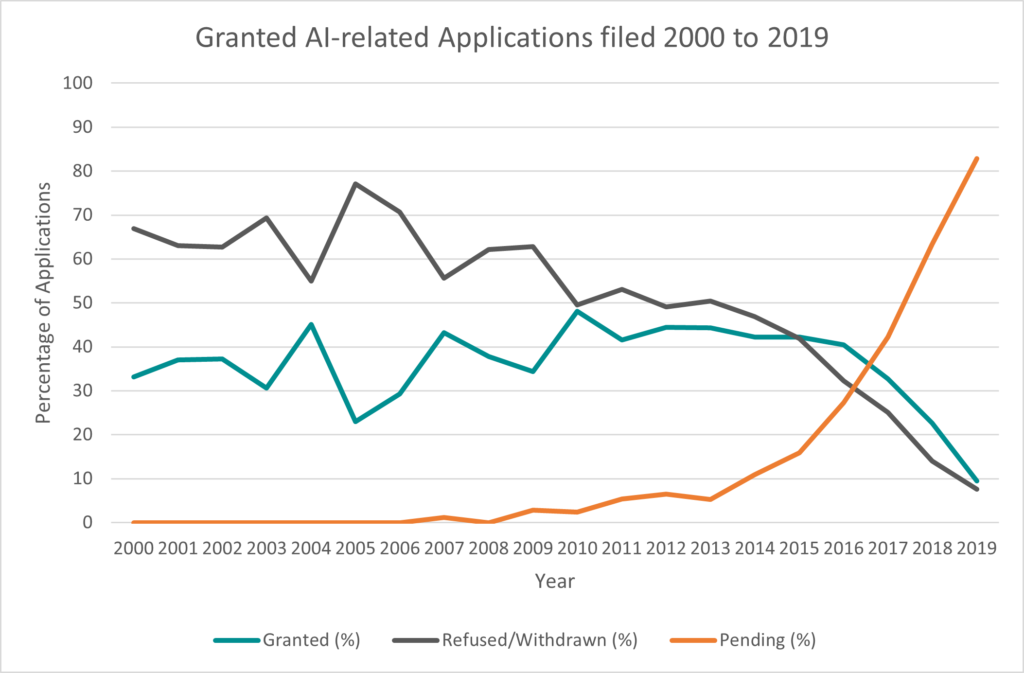
As mentioned, the number of patent applications filed for AI-related inventions continues to increase. Therefore, we expect to see an increase in grant rate (i.e., the overall chance of each application successfully leading to a granted patent) as applicants get more of an indication of what subject matter would be deemed allowable at the EPO, and focus their filings to such subject matter. Consistency of decisions should stabilise further as the EPO handles more and more AI applications and patent examiners become more familiar with applying the law across the broad range of AI-related inventions.
Figure 6 below perhaps demonstrates the change in grant rate best. Figure 6 shows the year-on-year grant rates for AI applications which are no longer pending, i.e. the proportion of applications filed in each year which have been granted vs been refused. As can be seen in Figure 6, the grant rate of the applications which have had an outcome from the patent office has been increasing. Of the applications filed in the last 10 years which have reached an outcome, over 45% of applications have been granted.
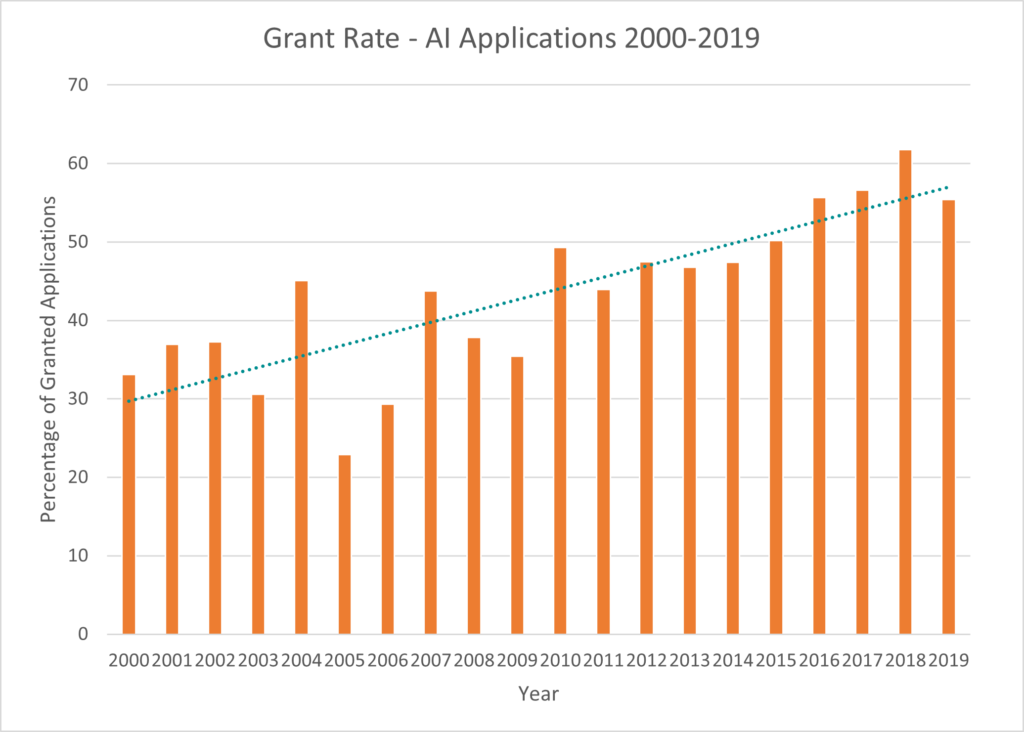
This apparent positive increase in the likelihood of successful grant, combined with the increase in patent applications being filed each year, will continue to result in an overall increase in the number of AI granted patents year-on-year. We note, however, that as a large number of applications filed in the last 5 years are still pending, it is possible that the applications which are taking longer to grant, and having more objections raised by the patent office, have a higher chance of being refused than those granted quickly after filing. We will keep monitoring this trend over the coming years, and hope to see the EPO continuing to view AI-related inventions more favourably.
Lastly, it is worth remembering that even though grant rates appear to be increasing, a patent application can serve many purposes. Although the main purpose of a patent application is to try to obtain a monopoly right, some applicants may be filing speculative applications in disruptive technologies as a starting point for business negotiations, even if specialist advice is that the application may not, or even is not likely to, succeed. Pending patent applications can also be useful tool in tech transfer negotiations and business floatation’s and sales, to demonstrate what the technology is as well as what similar technology is known.
Summary
In summary, the outlook seems positive for AI innovators, in patent terms at least. The number of AI applications is skyrocketing, the number of patents being granted is following a similar trend, and the percentage chance of grant for each application filed also appears to be increasing.
At Reddie and Grose we have a wealth of experience seeking legal protection, especially UK and European patents, for inventions relating to Artificial Intelligence. If you need help protecting your innovations in this field then please do get in touch.
This article is for general information only. Its content is not a statement of the law on any subject and does not constitute advice. Please contact Reddie & Grose LLP for advice before taking any action in reliance on it.


